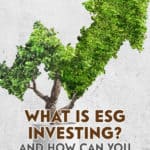What Is ESG Investing and How Can You Find ESG Stocks?

Increasingly, investors are looking beyond financial factors when it comes to choosing investments for their portfolios. How large companies manage various environmental, social, and corporate governance issues matters to a growing segment of society, affecting people’s investment decisions.
This focus on sustainable investing has a name: ESG Investing. Some refer to it as Socially Responsible Investing (SRI), but there are differences between them. In this article, I’ll explain the pros and cons of ESG Investing to help you decide if it’s right for you.
What Is ESG Investing?
The ESG stands for Environmental, Social, and Governance. More and more companies realize that prioritizing sustainability is good for the corporate image and can also boost the balance sheet.
ESG Factors
There isn’t a clearly defined set of ESG factors, but the following list includes many common values that ESG investors are looking for in a company or investment fund:
Environmental
- Climate change policies
- Reducing carbon emissions
- Deforestation
- Renewable energy usage
- Clean water
- Air/water pollution
Social
- Supporting human rights
- Working to improve labour standards
- Community engagement
- Prioritizing diversity
- Customer service performance
- Employee turnover
Governance
- Corporate accountability
- Ethical business practices
- Lobbying activities
- Executive pay
- Board diversity
- Potential for conflicts of interest
ESG vs. SRI Investing
One could say that ESG Investing evolved out of Socially Responsible Investing(SRI), which has been around for a while now. It can be challenging to tell the difference between the two. With SRI Investing, the aim is to avoid certain businesses or industries based on a predetermined set of values.
For example, an SRI investor might stay away from any fund or company tied to weapons manufacturing, alcohol or tobacco, or pornography. The motivation could be religious or other cultural beliefs. For more information, check out our article on SRI investing.
ESG isn’t about avoiding specific “sin industries”; instead, it aims to identify sustainable practices across a broader spectrum. For example, an environmentally conscious ESG investor would be interested in companies addressing climate change by reducing their carbon emissions.
How to Measure ESG Performance
You may be wondering how to measure a company’s ESG performance. After all, there isn’t one set of guidelines, and not all companies make an ESG commitment. It is 100% voluntary.
Analyze the Proper ESG Reporting
ESG companies will publish their sustainability goals and should be providing investors with regular reporting of their progress. To do this, they will often adhere to a recognized standard, such as the Principles for Responsible Investment (PRI). PRI is a set of six principles for responsible investment. They are supported by the United Nations, which gives them global recognition. According to PRI’s website, they are voluntary and aspirational and act as a road map for “incorporating ESG issues into investment practice.”
To ensure a company’s ESG data is of high quality, stick to reporting that aligns with PRI or a suitable alternative.
Analyze ESG Ratings
One way to quickly screen ESG investment funds is to refer to ESG ratings that a neutral, 3rd party publishes. MSCI and Sustainalytics publish two of the most in-depth ESG ratings. These organizations aim to improve ESG transparency. The MSCI database lets you search over 2,800 companies and easily measure their ESG risk across various categories. ESG ratings include a helpful comparison between industry peers.
Benefits of ESG Investing
Like anything else, ESG Investing has its pros and cons. Let’s take a closer look at some of the benefits and drawbacks.
ESG Companies and Strong Leadership
Companies that adhere to ESG principles tend to be forward-thinking, with solid leadership. Over the long term, this bodes well for company performance and investor returns.
Increased Options for ESG Investors
While ESG and SRI Investing were once considered a niche or fad, it is quickly becoming mainstream. Considering the current cultural landscape in much of the western world, it doesn’t appear that things will change any time soon. High-quality ESG portfolios will continue to be made available, and investors can feel good about themselves and expect solid returns.
You’re Helping to Create a Sustainable Future
When you target ESG investments in alignment with your values, you’re helping shape the future in a small way. Companies that can attract investment have more money and will increase their market share as their influence grows.
Drawbacks of ESG Investments
It’s essential to keep in mind that there are also risks to ESG investing. Here are a few:
ESG Reporting Is Voluntary
Companies are not mandated to maintain their ESG commitments or their reporting. You could invest thousands of dollars in a business only to have things change negatively down the road.
Loose Connection Between ESG Values and Financial Performance
It can be difficult to calculate the financial benefits of many ESG commitments. For example, how a company’s customer satisfaction index translates to customer retention and overall profitability.
Difficult to Evaluate ESG Performance
Because there is no universal standard for measuring a business’s ESG performance, it can be difficult to evaluate different ESG funds. When making ESG considerations, you have to be willing to do the proper research, which takes time.
How To Buy ESG Investment Funds
There is no shortage of ESG stocks and mutual funds available today. While you can purchase individual stocks, the simplest way to build an ESG portfolio is by buying one or more sustainable ETFs. Two of the more popular funds in Canada are the iShares Jantzi Social Index ETF (XEN), and the Desjardins RI Canada-Low CO2 Index ETF (DRMC).
The best way to purchase funds like these is through a discount brokerage. If you don’t already have an online brokerage account, I recommend Questrade and Wealthsimple Trade. Both have no-fee ETF purchases, which helps to keep your investment costs to a minimum. Questrade offers a more comprehensive trading experience, while Wealthsimple’s mobile-only trading app is ideal for beginners.
ESG Investing: The Bottom Line
Sustainable investing and strong financial performance are no longer mutually exclusive; you can have the best of both worlds. With a solid understanding of your values and a willingness to do some research on the financial markets, you can build an ESG portfolio that achieves solid returns over the long term.
If this sounds intriguing, I recommend that you get started by learning more about ESG principles, such as the PRI as mentioned earlier, as well as the MSCI and Sustainalytics reports. Once you’ve developed your ESG strategy, you can use your preferred robo-advisor or online brokerage to begin building your portfolio.

